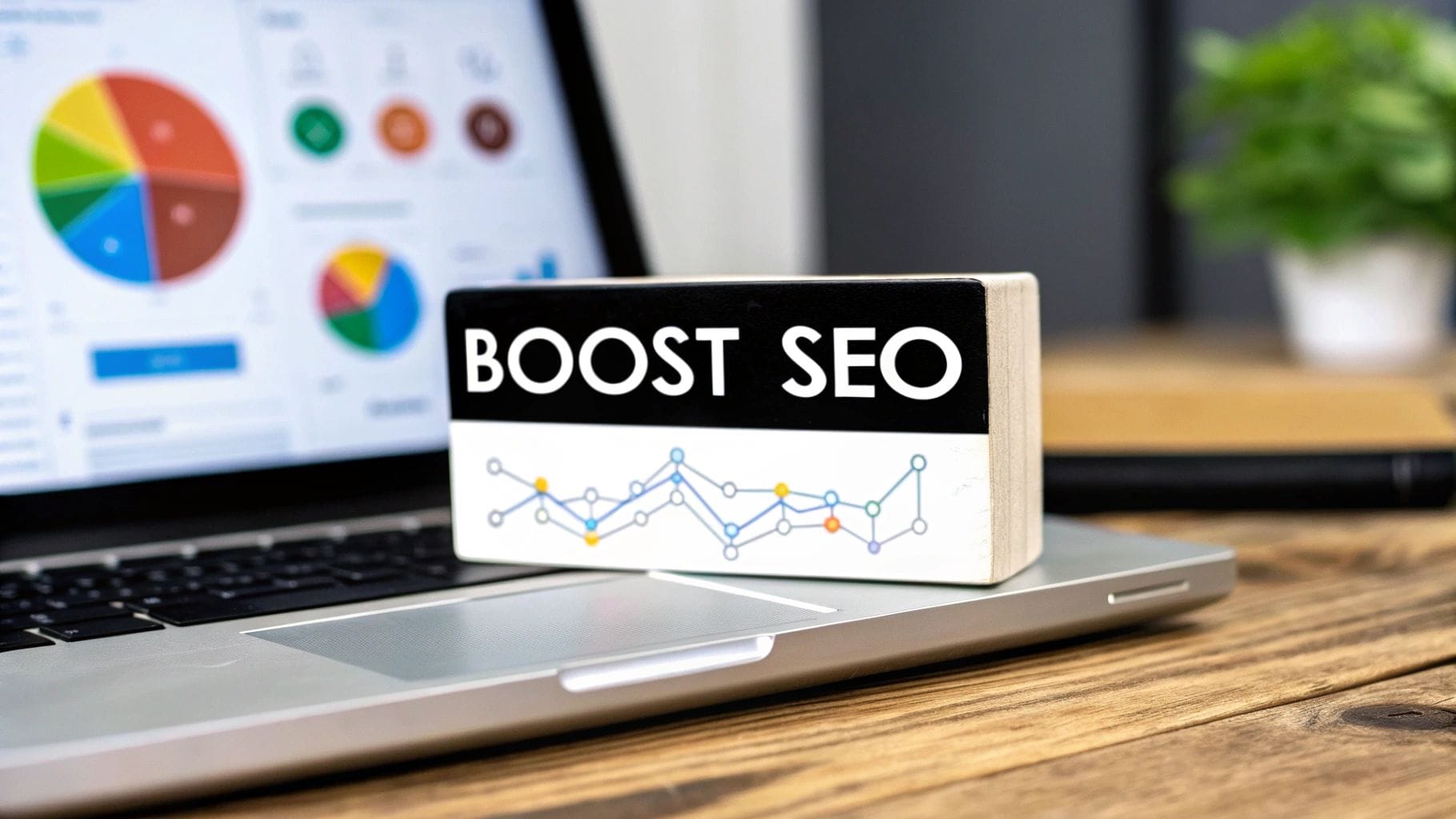The Global Ecommerce Landscape: Your Growth Opportunity

The ecommerce world is experiencing remarkable growth, offering businesses of all sizes a significant chance to expand their sales. This isn’t simply a fleeting trend; it represents a fundamental change in consumer shopping habits. Understanding this evolving market is the first step towards harnessing its power.
Key Growth Drivers In Ecommerce
Several factors fuel this expansion. Increased access to the internet and the widespread adoption of mobile devices have opened up new markets, making online shopping more convenient than ever. The COVID-19 pandemic also played a significant role, accelerating the shift to online shopping and cementing its place in our daily routines. Businesses that embrace ecommerce are now strategically positioned for long-term success.
The market’s size is truly impressive. In 2023, global retail ecommerce sales reached an estimated $5.8 trillion. Projections indicate this number will climb to $8 trillion by 2027, reflecting a substantial annual growth rate between 7.6-8.4%. This rapid growth underscores the immense potential for businesses to boost their online sales. China and the United States are major players in this arena, with combined sales surpassing $2.32 trillion in 2023 alone. This impressive figure is fueled by increased investments in ecommerce platforms, the growth of online marketplaces, and the adoption of omnichannel strategies. Learn more about current ecommerce statistics here.
To help illustrate these growth patterns, let’s take a look at the following table:
Global Ecommerce Growth Trends
This table showcases the growth of ecommerce sales globally and by major regions.
| Region | 2023 Sales (in $ trillion) | Projected 2027 Sales (in $ trillion) | Annual Growth Rate |
|---|---|---|---|
| Global | 5.8 | 8.0 | 7.6-8.4% |
| China & US Combined | 2.32 | N/A* | N/A* |
*Data not available for combined China/US projections for 2027.
As this table highlights, the global ecommerce market is on a significant upward trajectory. Understanding these trends is crucial for businesses looking to capitalize on this growth.
Navigating The Competitive Landscape
This growth, however, also brings increased competition. To thrive in this dynamic environment, businesses must differentiate themselves with effective strategies. Understanding marketing positioning is essential for gaining a competitive edge. This includes focusing on specific niches, optimizing product pages, and leveraging online marketplaces like Amazon, which saw an astounding six billion direct visits in Q1 of 2024. Enhancing user experience and streamlining delivery options are also critical for attracting and retaining customers.
Regional Variations And Consumer Behavior
Consumer behavior differs significantly across regions. While mobile commerce dominates in Asia, with markets like China and South Korea seeing over 70% of online sales through mobile devices, other regions show different preferences. Businesses must tailor their strategies to specific target markets for maximum impact. This involves understanding local cultural nuances, payment preferences, and delivery expectations. By adapting to these variations, businesses can effectively expand into new markets and boost ecommerce sales on a global scale.
Mastering Mobile: Where Your Sales Growth Begins

The ecommerce world is going mobile. This creates a huge opportunity to boost online sales. Ignoring mobile optimization isn’t a choice anymore; it’s essential for any business that wants to survive and thrive. Smartphones are now the main device people use to shop online, outpacing desktops and tablets in both site visits and orders.
This mobile-first mindset isn’t just a passing fad; it’s a real change in how consumers shop. In 2024, smartphones made up almost 80% of retail website visits worldwide. This mobile dominance is even stronger in Asia. Countries like China and South Korea see over 70% of their online sales coming from mobile devices. Increased access to mobile tech, even in areas with limited internet access, is driving this shift. This highlights how vital mobile integration is for retailers who want to reach more customers and increase ecommerce sales. More detailed statistics can be found here.
Understanding Mobile User Behavior
To optimize for mobile effectively, it’s essential to grasp the unique psychology of mobile shoppers. Mobile users are frequently on the move, wanting quick and easy experiences. They have little patience for slow loading times, complex navigation, or difficult checkout processes.
Any hurdle in the mobile shopping journey can lead to abandoned carts and lost revenue. That’s why a user-friendly mobile experience is so important.
Key Elements of Mobile Optimization
Several crucial components contribute to a winning mobile optimization strategy. Here are a few key elements:
- Responsive Design: Your website needs to adapt smoothly to any screen size.
- Fast Loading Speed: Keeping load times short is key to preventing user frustration and high bounce rates.
- Simplified Navigation: A clear, easy-to-use navigation structure makes browsing simple.
- Streamlined Checkout: A fast and simple checkout, preferably with one-click purchase options, is essential.
- Mobile-Targeted Marketing: Tailor your marketing messages and deals to resonate with mobile users.
Prioritizing Mobile Improvements
Figuring out how to grow ecommerce sales through mobile means focusing on improvements that have the biggest impact on revenue. This means concentrating on the areas most likely to increase conversions. Sometimes, small tweaks, like optimizing the checkout process or speeding up the site, can significantly boost sales.
Mobile Optimization Checklist
To guide your mobile optimization efforts, use this checklist:
The following table, “Mobile Shopping Optimization Checklist,” provides a comprehensive outline of elements to implement to drive increased sales through mobile optimization.
| Optimization Element | Impact on Sales | Implementation Difficulty | Priority Level |
|---|---|---|---|
| Responsive Design | High | Medium | High |
| Page Load Speed | High | Medium | High |
| Simplified Navigation | High | Low | High |
| Streamlined Checkout | High | Medium | High |
| Mobile-Specific Promotions | Medium | Low | Medium |
This checklist prioritizes elements like responsive design, page load speed, simplified navigation, and a streamlined checkout process, all of which have a high impact on sales. While mobile-specific promotions are valuable, their implementation is classified as a medium priority due to the potentially lower impact compared to the other core elements.
By focusing on these core mobile optimization elements, you can effectively target this growing market segment and dramatically improve your ecommerce sales. This mobile-focused strategy not only makes things easier for your customers but also boosts engagement and drives conversions.
Transforming Product Pages into Revenue Engines

Your product pages are essential for e-commerce success. They are the final step in the customer journey, bridging the gap between browsing and buying. Think of them as powerful tools for persuasion, not just information hubs. By understanding customer psychology, you can optimize these pages to dramatically boost sales. This means actively engaging shoppers and guiding them towards a purchase.
Elements of High-Converting Product Pages
Several key elements contribute to successful product pages. High-quality images and videos are essential. They let customers visualize the product and its benefits. Detailed product descriptions are also vital. These should address key features and answer common questions, building trust and reducing hesitation.
For example, showcasing the texture of a fabric or demonstrating a gadget’s functionality through video can significantly enhance a customer’s understanding and desire. Clear and prominent calls to action are also important, guiding the customer towards the purchase seamlessly.
The Power of Social Proof
Social proof is another powerful tool for boosting e-commerce sales. Customer reviews, testimonials, and social media shares build confidence in potential buyers. People trust peer experiences more than brand claims.
Displaying star ratings and positive reviews directly on the product page can greatly influence buying decisions. Showing how many people have recently viewed or purchased a product creates a sense of urgency and popularity.
Optimizing for Conversions
Continuous testing and optimization are essential for maximizing the effectiveness of your product pages. A/B testing different elements, like headlines, images, and calls to action, helps identify what resonates best with your audience.
This iterative process allows for fine-tuning. For instance, test different product descriptions to see which language and tone produce higher conversion rates. Analyzing user behavior on your product pages helps identify friction points and implement improvements. This ensures your pages are constantly evolving and driving higher sales and revenue.
Pricing Strategies That Boost Margins and Conversions

Optimizing product pages and mobile experiences is critical for driving conversions. But pricing strategies are just as important for increasing e-commerce sales and maximizing profits. Simply discounting products can shrink your margins and devalue your brand. Savvy retailers are using strategic pricing models to boost revenue and enhance customer lifetime value. Let’s explore some of these advanced tactics.
Psychological Pricing Techniques
Understanding how consumers think is key to effective pricing. Charm pricing uses the power of “9” endings. A product priced at $9.99 feels much cheaper than $10, even though the difference is tiny. This tactic subtly influences buying behavior without significantly impacting profits.
Premium pricing, setting higher prices to suggest exclusivity and quality, can be very effective for certain products.
For example, a luxury brand might price a handbag slightly higher than competitors to create a perception of superior craftsmanship and make it more desirable. This attracts customers willing to pay more for perceived value.
Dynamic Pricing and Promotional Structures
Dynamic pricing lets retailers adjust prices in real-time based on factors like demand, competition, and even the time of day. This maximizes revenue, especially during busy shopping periods. You can capitalize on high demand and still offer competitive prices during slower times.
Promotional structures should aim to maximize customer lifetime value, not just initial sales. Think about offering bundled discounts or loyalty programs that reward repeat customers.
These programs build brand loyalty and create stronger customer relationships, leading to sustainable growth.
Developing a Pricing Calendar
Seasonal buying patterns offer great opportunities for strategic pricing. A pricing calendar helps you plan price changes throughout the year, taking advantage of holidays, special events, and seasonal demand. You might increase prices slightly during high-demand holidays or offer discounts in the off-season to clear out inventory.
By anticipating these trends and planning accordingly, you can maximize revenue and optimize inventory management. This proactive approach keeps your pricing strategy aligned with market conditions and what your customers expect. Careful planning and data-driven pricing are essential for success in e-commerce.
Checkout Optimization: Turning Browsers into Buyers
The checkout process is a crucial stage in any ecommerce sales journey. Unfortunately, a significant number of potential sales are lost at this final step. This means that even with a compelling product and effective marketing, a poorly optimized checkout can significantly impact your revenue. By understanding common pain points and the psychology behind checkout hesitation, you can implement strategies to convert more browsers into paying customers.
Identifying and Eliminating Friction Points
Several factors can contribute to cart abandonment. Requiring account creation, unexpected shipping costs, and limited payment options are just a few examples that can deter customers from completing their purchase. For instance, forcing account creation adds an extra, often unnecessary, step, pushing potential customers away. High or surprise shipping fees can also make an item suddenly seem less desirable.
One solution is to offer guest checkout options. This streamlines the process, removing the barrier of account creation. Transparency with shipping costs is also key. Displaying shipping costs upfront manages customer expectations and avoids last-minute surprises, increasing the likelihood of a completed sale.
Offering a variety of payment options is another important factor. Including popular digital wallets like PayPal and various credit card options caters to a wider audience. If customers can’t use their preferred payment method, they are more likely to abandon their cart.
The Power of One-Click Purchasing
Many leading retailers are now implementing one-click purchasing. This further simplifies the checkout process by securely storing customer payment and shipping information. Repeat customers can then complete purchases with a single click, significantly reducing the time and effort involved.
This frictionless experience can dramatically boost conversions. Fewer clicks generally translate to a higher probability of a sale. It also minimizes the chance for distractions or second thoughts that can occur during a longer checkout process.
Recovering Abandoned Carts
Some cart abandonment is inevitable, even with an optimized checkout. However, cart recovery tactics can help recapture these lost sales. Sending personalized emails reminding customers about abandoned items can re-engage their interest. A small incentive, like a limited-time discount or free shipping, can further encourage them to complete their purchase.
These reminder emails should be more than generic notifications. They should highlight the specific items left in the cart, reiterate their value, and ideally create a sense of urgency. Personalization is key to effectiveness. For example, including customer reviews of the abandoned product can offer social proof and nudge a hesitant buyer towards a purchase.
By addressing friction points, embracing one-click purchasing, and implementing effective cart recovery strategies, businesses can transform their checkout experience. This results in a smoother, more enjoyable purchasing experience for customers, ultimately boosting your bottom line and converting browsers into buyers.
Leveraging Data: The Decision-Making Advantage
The success of your ecommerce business depends on making informed decisions. However, not all data is equally valuable. While vanity metrics such as social media followers may seem impressive, they don’t always lead to increased sales. The real key to boosting ecommerce sales is understanding which metrics truly predict growth and how to use them to refine your strategies. This involves understanding key performance indicators (KPIs) and their direct relationship to revenue.
Identifying Key Performance Indicators (KPIs)
Instead of feeling overwhelmed by a massive amount of data, focus on KPIs that offer actionable insights. Conversion rate, the percentage of website visitors who complete a purchase, is a critical metric. A low conversion rate may suggest problems with your checkout process or product pages.
Average order value (AOV) shows how much customers spend per transaction. Increasing AOV through strategies like upselling or bundled discounts can significantly boost revenue. Furthermore, customer lifetime value (CLTV) predicts the long-term profitability of each customer, emphasizing the importance of customer retention.
For example, consider two online stores with the same number of visitors. The store with a higher conversion rate and AOV will generate more revenue, even with less traffic. This highlights why concentrating on these specific KPIs is essential for maximizing ecommerce sales. You can learn more about improving conversion rates with resources like this guide on how to improve conversion rates.
Segmentation for Revenue Opportunities
Segmentation, the process of dividing your customer base into distinct groups based on shared characteristics, can unlock significant revenue potential. By understanding the specific needs and behaviors of different customer segments, you can tailor your marketing messages and product offerings for maximum impact.
For instance, segmenting customers by their purchase history allows you to target high-value customers with personalized offers, increasing their CLTV. Similarly, segmenting customers by demographics or browsing behavior allows for more targeted advertising and product recommendations, which can significantly improve conversion rates.
Testing Methodologies for Reliable Insights
A/B testing is a vital methodology for validating data-driven decisions. By testing different versions of your website, marketing campaigns, or product pages, you can identify the most effective elements. This iterative process facilitates continuous optimization and ensures that your strategies remain aligned with customer preferences and market trends.
For instance, A/B testing different calls to action on your product pages can determine which wording results in higher conversions. This data-driven approach removes the guesswork and maximizes the effectiveness of your optimization efforts. By using these data-driven strategies, you can transform your decision-making process, resulting in sustainable growth and increased ecommerce sales.
Building a Loyalty Engine That Drives Repeat Revenue
Acquiring new customers is a costly endeavor. This makes repeat customers essential for sustainable growth in the ecommerce world. Transforming one-time buyers into loyal brand advocates is key to boosting sales and profitability. This involves shifting your focus from acquisition to building lasting relationships. This section explores proven tactics to cultivate loyalty and maximize customer lifetime value (CLTV).
Loyalty Structures That Generate High CLTV
Different loyalty programs offer unique incentives for repeat purchases. Points-based systems, for instance, reward customers with points for every purchase, which can be redeemed for discounts or free products. This encourages ongoing engagement and builds a sense of customer appreciation.
Tiered programs offer escalating rewards based on spending. This motivates customers to spend more to unlock better benefits. VIP programs provide exclusive perks like early access to sales and personalized service, creating a sense of exclusivity and strengthening customer loyalty.
For example, a tiered program might offer free shipping at the first tier. The second tier could offer a 10% discount, while the highest tier could include free expedited shipping and a 15% discount. This tiered structure motivates customers to ascend the ranks, ultimately leading to increased sales.
Post-Purchase Communication Drives Repeat Business
Communication after a purchase significantly impacts customer retention. Personalized thank you emails expressing gratitude and offering a small discount on the next order can create a strong positive impression. Product recommendation emails based on past purchases introduce customers to new items they might enjoy, prompting additional sales.
Requesting feedback through surveys demonstrates that you value customer opinions. This strengthens the customer relationship while providing valuable business insights.
Retention Metrics That Predict Future Revenue
Tracking key metrics allows you to measure the effectiveness of your loyalty programs. The customer retention rate measures the percentage of customers who make repeat purchases over a specified period. A high retention rate signifies a loyal customer base.
The repeat purchase rate indicates how frequently customers return to buy again. Higher frequency suggests strong customer loyalty and boosts sales. CLTV calculates the total revenue generated by a customer throughout their relationship with your business. Increasing CLTV demonstrates the long-term success of your retention strategies.
By implementing a strong loyalty engine focused on valuable rewards, effective communication, and data-driven decisions, you can significantly increase sales. This also allows you to build stronger customer relationships and a sustainable path to long-term growth. This strategic approach maximizes the profitability of each customer interaction, building a strong foundation for lasting success.
Are you interested in improving customer engagement and boosting conversions? Explore Notifyio, a resource hub focused on the power of social proof and conversion optimization for enhanced digital marketing performance.




Leave a Reply